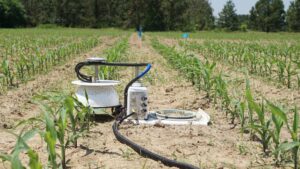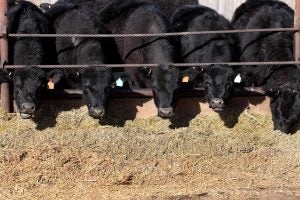The New York Times recently published an article titled, The Farming Conundrum, which outlines some of the skepticism about measuring the ag industry’s climate goals. But, do the NYT’s claims about farming and ranching’s approach hold weight?
The central question of the article, which was part of what the news outlet calls its Climate Forward newsletter, is whether the agricultural industry can handle the climate goals that it has started promising. Which, really, is a great question.
Here’s a snippet from the article.
“One thing is clear: There is a huge knowledge gap in our efforts to transform agriculture. Measuring agricultural emissions is a lot more complex than monitoring power plants and tailpipes. That makes it hard for any government to measure how well such techniques are working …”
The article, written by a journalist who had worked in Brazil, kicks off by criticizing Brazil-based JBS for how it approaches climate concerns. The meat processor has pledged to be net zero by 2040 but hasn’t published plans on how it will get there. New York Attorney General Letitia James has filed a lawsuit against the company’s U.S. subsidiary, JBS USA, alleging it misled the public about its environmental impact and its plan to increase production in the coming years.
One of the accusations in James’ lawsuit is that “there are no proven agricultural practices to reduce its greenhouse gas emissions.”
The article steers into this sentiment by citing the divisive Environmental Working Group and criticizing the U.S. Department of Agriculture for funding research that the article claims won’t help agriculture reduce its carbon footprint. (The EWG, which has been known to oppose scientific consensus, and the USDA have historically clashed over food safety, agricultural science, and farmer support, so the volleys of criticism here are no surprise.)
While the NYT’s author seems to suggest that agriculture as a whole is touting a goal without a way to achieve it, I — and many others in this industry — would strongly disagree.
Many sectors in ag have set goals for when they will be “net zero” and are actively making significant strides. Here are a few examples:
- Dairy industry — Net zero by 2050
- Beef industry — Net zero by 2040
- Pork industry — 40% reduction by 2030
To the article’s point, do you know how your farm is doing? What tools do you have to prove that your methane, carbon, and nitrogen emissions have been decreasing? If the climate police showed up on your doorstep tomorrow, what would you tell them?
What the NYT article doesn’t seem to understand is that agriculture has several pathways to reduce its carbon footprint.
Farmers and ranchers can reduce the amount of feed wasted at the bunk, the amount of gas coming from the livestock themselves, the amount of gasses released into the atmosphere from manure storage, the diesel fuel associated with moving manure and harvesting feed, and the gasses released from fields.
But the question right now isn’t where do we reduce emissions, it’s how do we measure all of this? Like the article says, we don’t have a single source like a tailpipe or smoke stack that all our greenhouse gasses flow out of, so it can seem tough to measure where we’re at in agriculture.

Yet if you look up “tools for measuring carbon emissions” you’ll find a bunch.
Many websites can “analyze” several factors and spit out assumptions about your carbon footprint. Well … you know what they say about assumptions. And with hard sustainability goals in place, assumptions cannot cut it anymore, which is what the NYT article is stating.
Yet the author failed to realize that agriculture does have the technology to measure greenhouse gas (GHG) emissions, and reduction is happening faster than we can measure it!
So, what tools do we have in agriculture?
Let’s start with soil. Soil is a living, breathing thing that takes in nutrients and carbon dioxide, but it also exhales nitrous oxide as it breaks down organic materials.
Soil scientists across the U.S. are using technology to measure nitrous oxide emissions from soil and exploring why. North Carolina State University professor Alex Woodly hosted an impressive research project to measure nitrous oxide output in soil, where they used machines that would be sealed over a small part of the field where crops were growing for 30 minute intervals to measure what was being released from the soil.

In a 2020 article about Woodley’s research, he said, “This data will help us model farming systems that balance crop yield and sustainability, and also help predict the impact of and recovery from environmental stresses, like floods and drought. … We think the soil holds the solutions.”
The Soil Health Institute is also working hard at measuring the greenhouse gas (GHG) emissions coming from and consumed by croplands. The institute has committed to researching GHG emissions from crop fields for at least six years before recommending practices to farmers.
Some of its ongoing research on dairy farms concerns carbon dioxide, methane, and nitrous oxide emissions from cultivating crops, water quality and quantity around cropland, and yield and forage quality.
The Soil Health Institute is a global initiative that brings everyone together with one common goal: achieving net zero in agriculture through soil health. We may not have all the tools we need yet to be successful, but the Soil Health Institute is making quick progress, and they are proactive at sharing what farmers can start doing today.
While soil is one piece of the puzzle, feed is another. Cows, for instance, eat a lot of feed in order to produce meat and milk. The topic of using fewer inputs for the same amount of output has long been part of the conversation.

Some semen companies have started marketing “eco genetics,” which make the next generation of cows genetically more feed efficient.
It seems a little too good to be true, but we know that feed efficiency is directly linked to genetic makeup. Measuring feed efficiency is as easy as dividing feed input by product output. The more efficient our livestock can be, the less feed we need to produce. Think of how much less driving, planting, picking, and packing there would be if our animals were all a little more efficient!
Effective crop production and harvest really comes into play when talking about feed efficiency as well, which is why farmers talk extensively with experts when choosing the best seed varieties for their operations, hoping to have a large percentage of crops harvested at the optimal time.
This is especially true for animals that are fed forages — corn silage is a great example of this. Farmers want to balance the energy (the kernels) with the fiber (all the green parts), but they have to harvest when the corn reaches a certain percent moisture. If corn is harvested too early, it’ll be too wet and it will not have enough ear development. If it’s harvest it too late, it will be too dry and won’t ferment.
Feed-efficient animals and high-quality harvests can take us to another level when it comes to GHG emissions.
Manure usage is yet another avenue in animal agriculture targeted for improvement. It has been the tricky part of measuring ag’s overall footprint, but that’s changing quickly!
The U.S. Environmental Protection Agency has published a list of best practices to reduce methane emissions from cattle. The agency explains that manure produces methane under anaerobic conditions. This means that if you’re unable to have a manure digester or dry your manure, the more breathing room it has the better. The best practice (behind an anaerobic digester of course) is spreading manure daily.
Most of the methane released while growing cattle is actually released before the manure happens — yes, burps are the cow’s biggest source of methane.
There has been research on how methane is made in ruminants’ bellies (a process called methanogenesis), and how to stop it. The idea of feeding cows seaweed to reduce methane has gained a lot of traction, because there is research that proves that there are certain compounds found in some seaweed that stop methanogenesis from occurring.
Seaweed isn’t the easiest crop to harvest, and it’s not the most palatable, so its effects long term on health, production, and reproduction on a modern farm haven’t yet been studied. Even so, we know that we may be able to feed ingredients to greatly reduce methane production.
Additionally, Cornell University is about to open the country’s first climate-controlled respiration chamber that will be able to measure the GHG emissions of a cow in great detail under different circumstances. This is really opening the door for the agriculture industry to make big changes — and actually measure them!
Joseph McFadden, the researcher heading up the climate-controlled respiration chambers and coming research projects, anticipates that the team will have a ribbon-cutting ceremony in April 2024, and, hopefully, many projects will be quick to follow.
While the NYT article got it partly correct — it is hard to measure GHG emissions in agriculture — the knowledge gap is closing, and we can measure more every day.
Agriculture has made some hefty promises when it comes to sustainability, but with all our technology to measure GHG emissions from the soil, manure, feed efficiency, and out of livestock bellies, we surely are making progress.
Elizabeth Maslyn is a born-and-raised dairy farmer from Upstate New York. Her passion for agriculture has driven her to share the stories of farmers with all consumers, and promote agriculture in everything she does. She works hard to increase food literacy in her community, and wants to share the stories of her local farmers.



